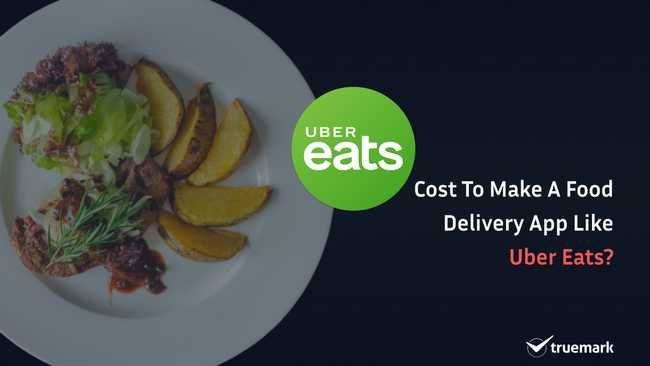
You order food and get it delivered to your door. Such a hassle-free and convenient process make food delivery apps like Uber Eats, Zomato, DoorDash, Grubhub, Swiggy, etc., famous and successful worldwide. With the likes of these apps, the food industry has evolved recently and become an instant hit among people. Thanks to these platforms, your favorite foods are just a few taps away.
In 2020, food delivery apps generated $26.5 billion (increment by 204 percent in the past five years) in revenue in the US only. There are more than 111 million users (increment by 116 percent) in the US. This is why many people are taking the growing popularity of food delivery apps into consideration and planning to invest and build one themselves. However, there always arises a question- how much does it take to make a food delivery app like Uber Eats? So, stay with us till the end to know the total development cost of such platforms.
Before we head to the total development cost, let’s see what we need to consider before building a food delivery app.
Types of food delivery app
Currently, there are three types of food delivery apps that you can consider when building the app.
Aggregator
The aggregator business model involves only the users and the restaurants. The users place the order, and the restaurant itself delivers the food. There isn't the involvement of any third party whatsoever.
The working mechanism includes:
- The restaurants upload their menus.
- The users browse the menu, select the food, place the order, and pays for the bill from within the app (if they prefer online payment)
- The restaurant gets the notification and prepares food.
- The food is delivered to the users by the restaurant's delivery man.
- The users pay the bill if they prefer cash on delivery.
Example: Grubhub
Logistic Support
Logistic Support is the same as the aggregator. However, the main difference is that the food is delivered to the users by the platform's couriers.
The working mechanism includes:
- The restaurants upload their menus.
- The users browse the menu, choose, place the order, pays the bill from within the app (online payment)
- The restaurant gets the notification and prepares food.
- The food is delivered to the users by the platform's courier
- The users pay for the bill if they prefer cash on delivery
Example: Uber Eats
Hybrid Platform
In a hybrid platform, the users place the order, the restaurant prepares food, and a third-party courier service delivers the food.
In this business model, the platform's owner hires another third-party courier service to complete the order.
The working mechanism includes:
- The restaurant uploads the menu.
- The users browse the menu, select, place the order, and pays for the bill (online payment)
- The restaurant gets the notification and prepares food.
- The third-party courier service delivers food to the users.
- The users pay the bill if it is cash on delivery.
Example: DeliverThat
How does it work?
Before developing an app like Uber Eats, it is necessary to consider connecting with restaurants, bakeries, hotels, etc. Once everything is okay, then it is time to develop the app. Without them, it will be challenging for you to move forward unless you own a restaurant.
Once the order is completed, the profit margin is split between the restaurant owner, the app owner, and the courier service.
Why is it booming?
People are adapting and changing, and so is their lifestyle. They are busy with their work. So, using a food delivery app has become an integral part of their life. However, this is not the only reason. There are many others, like
- Saves time: The users can complete their chores and essential tasks before the food arrives.
- Convenient: It is comfortable and convenient to use the food delivery app and get the food with just a few taps.
- See review and ratings: The users can see the feedback of other customers before ordering food from a particular restaurant.
- Anytime, Anywhere: You can order food at any time, anywhere (if it or similar apps are available in your region).
- Multiple payment options: Online payments make it easier for users to pay easily and quickly.
- No geographical and demographic restrictions: Food delivery app can be operated in different regions/places at the same time, so there aren't any geographical restrictions.
- Fast delivery and on time.
- Wide range of cuisine to choose from.
- Available 24/7
Revenue models
Here are the monetization strategies of Uber Eats.
- Delivery fee from customers: Food delivery apps like Uber Eats charges delivery fees from customers after completing the order. It ranges from $1-$5, depending on the location.
- Revenue from restaurants: Normally, Uber Eats gets a 15%-40% commission on each delivery from its partnered restaurants.
- Advertisements: Uber Eats promotes their partnered restaurants to the customers through social posts, brand campaigns, etc. As a result, it charges marketing fees from them.
Food delivery app features
Here is a breakdown of features to consider when developing a food delivery app like Uber Eats.
User/Customer Panel
Registration and Login: With the registration and login process, the users should be able to use the app.
Search: The users should be able to search nearby restaurants.
Location: The users should be able to pick a destination and track the location of their order.
Menu: The users should be able to browse the menu.
Checkout and Payment: The users should be able to place the order and choose the payment options that suit them best.
Review and Ratings: This feature helps users to provide reviews and ratings. Also, it allows them to see other customers' experiences regarding the services and taste.
Profile Management: The users should be able to change the language settings, contact information, payment options, locations, etc. Also, see the order history, past payments, etc.
Cart: The users should be able to add or delete the food into the cart before placing the order.
Push Notifications: This feature lets users know about the different offers and status of their orders.
Restaurant Panel
Login: This feature allows the restaurant and its employee to use the app and know the orders placed by the customers.
Order management: This feature lets the restaurants know the incoming orders. Also, it helps them either accept or decline the orders.
Push Notifications: To get notifications when the users place an order.
Reviews and Ratings: The restaurant should be able to see the reviews and ratings provided by the customers.
Menu Management: This feature allows restaurants to update their menu and price.
Courier Panel
Login: Each courier or delivery boy has the credentials to log in to the app.
Order information: The delivery boy should get information, like the customer's name, destination, payments status, etc.
Order history: This feature allows the courier to see and save all the orders.
Order status: The courier should be able to maintain the status, like delivered, on the way, etc.
Notifications: This feature allows the courier to know when an order is placed.
Location: This feature allows the courier to track the exact location of the customers.
Admin Panel
Login: To sign in to the app and manage it.
Payment Management: To add or delete the payment options. Also, to change and update the fees and commissions.
Restaurants Management: To add or delete the restaurants.
Offer Management: To add or delete offers, like discounts, bonuses, etc.
Analytics: To know about the earnings, profit, popular locations, popular restaurants, etc.
Technology stack and development team
Mainly, the technology stack depends on what technologies the software company uses to develop a food delivery app.
Here is a list of technologies Uber Eats uses:
- Programming Language: Node.js
- UI Frameworks: Vuetify
- PaaS (Platform as a service): Amazon Web Services
- JavaScript Frameworks: Vue.js, Nuxt.js
- File Hosting: Amazon S3
Source: Wappalyzer
The development teams to develop the food delivery app may include:
- UI/UX Developer
- iOS Developer
- Android Developer
- Web App Developer
- Project Manager
- Backend Developer
- QA
Total development cost
The total development costs to develop a food delivery app like Uber Eats usually depends on the complexities and features it needs. Also, it depends on the locations the company or the developers are located in.
- USA: $46.32/hr
- Germany: $56/hr
- UK: $71/hr
- Sweden: $67/hr
- Ukraine: $37/hr Source
Here is a rough estimation of the total development cost based on the average hourly rate in our region Asia ($30/hr).
| Features | Platforms | Time (hr) | Cost ($) |
|---|---|---|---|
| Customer Panel | Android+iOS+WebApp | 1000-1300 | ~39,000 |
| Restaurant Panel | Android+iOS+WebApp | 900-1000 | ~30,000 |
| Courier Panel | Android+iOS+WebApp | 800-900 | ~27,000 |
| Admin Panel | Android+iOS+WebApp | 400-500 | ~15,000 |
| Total | 3,700 | ~111,000 |
As you can see above, the development cost of building an app like Uber Eats cost approximately $111,000.
We provide a free consultation service to our customers. So, get a thorough estimation by contacting us.
Planning to make an app like Uber Eats?
The popularity and the craze for food delivery apps are increasing with the rise in the Internet and mobile usage. If you plan to make an app like Uber Eats, please feel free to get in touch with us.
Truemark Technology is a software company providing its services for the past five years. Recently, we worked on a similar project, LoveWithFood. See full detail in our portfolio.
Don't hesitate to reach us for a free consultation. Call us or send us a message or an email to get a more accurate estimation of making a food delivery app like Uber Eats and discuss the project's details.
